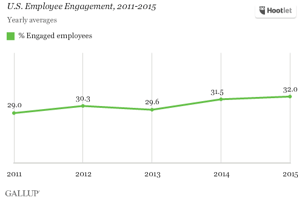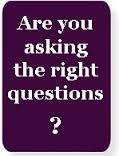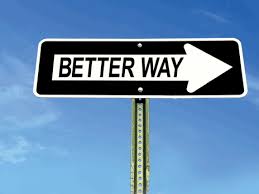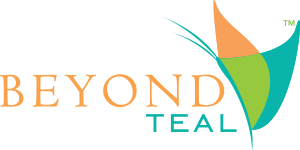Engagement or Performance?
 The business community is concerned. Since the year 2000, Gallup has tracked employee engagement and has found that less than one-third of U.S. employees have been engaged in their jobs and workplaces during the last 15 years. Expand that to global measurements and the numbers drop to less than 10 percent.*
The business community is concerned. Since the year 2000, Gallup has tracked employee engagement and has found that less than one-third of U.S. employees have been engaged in their jobs and workplaces during the last 15 years. Expand that to global measurements and the numbers drop to less than 10 percent.*
My consulting practice backs up Gallup’s reports. We asked individuals in leadership roles this question: What would a virtuoso in their role be doing for your company on a daily basis? The answer? Collectively, employees spend less than 10 percent of their time on the functions and activities that emphasize their level of genius and skilled talents.
This folks, is an engagement crisis and it’s creating swaths of stagnating organizations and a miserable workforce. Consider the symptoms — a sluggish response to challenges, lack of a higher sense of purpose, and unsatisfied employees. Not to mention a stale or frenetic work environment bogged down in waste and inefficiencies.
Ask the Right Question
 But is engagement the real issue? Think about it. At any moment in time a person is engaged in something. Writing a report. Making phone calls. Eating a cookie. Checking Facebook. Reading this blog post. However, while someone is always engaged in an activity, not every activity is for the betterment of the company. And that’s the key.
But is engagement the real issue? Think about it. At any moment in time a person is engaged in something. Writing a report. Making phone calls. Eating a cookie. Checking Facebook. Reading this blog post. However, while someone is always engaged in an activity, not every activity is for the betterment of the company. And that’s the key.
Let’s dig a little deeper. In regards to betterment of the company, if an employee provides an acceptable performance but is miserable doing so, is that acceptable? Could be. Depends on the organization. But having a person who is merely performing tasks and not excelling at them creates a gap in potential. And what happens if an organization’s leadership and staff are not realizing their full potential? You get a stagnating organization! Unrealized talent in staff really does show up on the bottom line. An unhappy, unsatisfied employee is not contributing to the betterment of the company.
Maybe the golden engagement question is this: what is the level of performance that an organization wants, needs … in fact … craves from each and every employee? Here’s a hint: the highest level of performance comes from an individual who is reaching his or her full potential.
Make Meaningful Changes
 Why do organizations focus on engagement when what they really want is staff that can reach their greatest potential? The concern over engagement has increased along with the attention organizations have given to the issue. Yet the Gallup measurements haven’t budged in more than a decade! What gives? Where is the attention going?
Why do organizations focus on engagement when what they really want is staff that can reach their greatest potential? The concern over engagement has increased along with the attention organizations have given to the issue. Yet the Gallup measurements haven’t budged in more than a decade! What gives? Where is the attention going?
Good intentions but misguided understanding creates some serious shortcomings in the attempts on the part of organizations’ efforts to improve engagement. Some of these shortcomings, uncovered by Gallup, include:
- Providing surveys asking staff for input and calling that engagement. You fill in a bubble that indicates that you want fewer meetings and boom, you’re engaged? Hardly.
- Focusing too heavily on data rather than developing management and employees.
- Defining engagement as the number of staff members who are simply not dissatisfied or merely content instead of asking how many staff members embrace a strong sense of involvement, commitment, and enthusiasm.
- Relying on measurements that tell the leadership what they want to hear rather than unveiling management or organizational issues that hinder performance.
- Attempting to appeal to staff’s superficial needs instead of treating staff members as true, respected stakeholders of their future and the organization’s future.
There Is A Better Way

The concept of the Teal Organization (as referenced by Frederic Laloux in his seminal book, Reinventing Organizations) and Holacracy have been designed in the belief that the current popular hierarchical model stifles initiative. Self-led management is capable of unlocking your staff’s unique intelligences and talents to organically improve the organization. Self-led management facilitates an individual to reach his or her full potential. Self-led management is a system that lets employees figure out how to increase their own engagement.
Think about it. How often do you see the terms takes initiative, self-starter, and self-motivated listed as desirable employee traits? Organizations ask for self-managed individuals then squash them with hierarchical leadership.
Beyond Teal & Holacracy
Beyond Teal guides leaders into finding purpose and wholeness in their personal and professional life in such a way that the organization fulfills its highest potential and that of the staff as well. One of the many positive by-products of this approach includes unlocking the multiple intelligences and talents residing in each and every staff member. Engagement and high performance become a natural asset.
These are traits of organizations that hold the Teal moniker. But where exactly does Holacracy fit in all this? We’ll crack that question open in Holacracy Part II: OS Holacracy.
# # #
Curious for more on Holacracy? Bruce Peters is a certified Holacracy Trainer. Contact him and get your conversation started!
Bruce Peters has spent the last 15 years living his own “Third Act.” Based on his personal experience and in working as a guide for hundreds of leaders, he has designed a unique process for getting beyond where you are and into the creation of your own Third Act for you or your organization. It starts with the question of what is the difference you want to make? Learn more at www.beyondteal.com.
* http://www.gallup.com/businessjournal/188033/worldwide-employee-engagement-crisis.aspx


